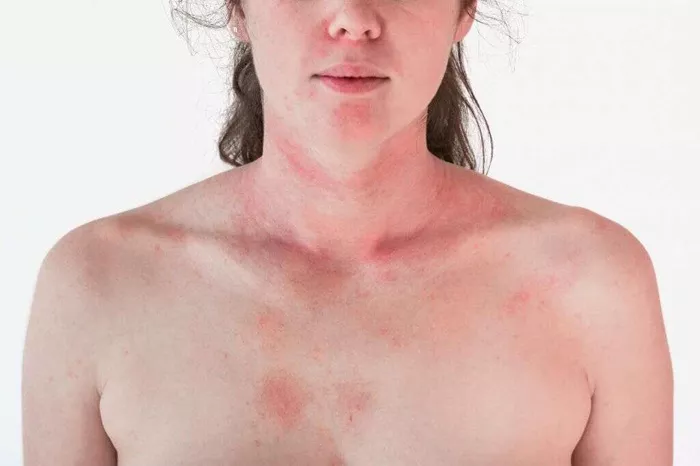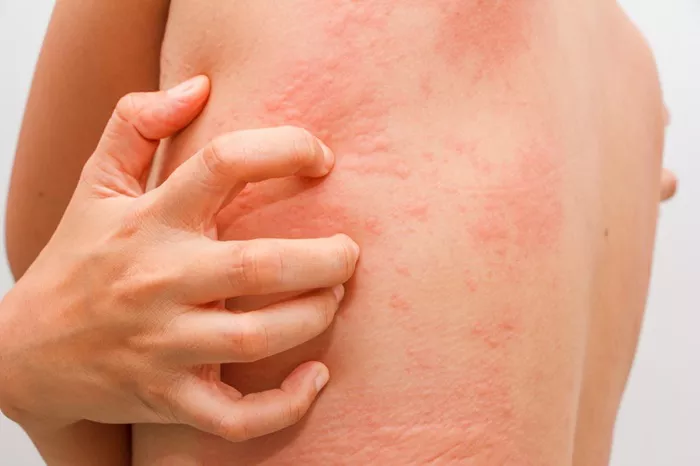Food rashes, also known as food allergies or food-induced dermatologic reactions, can manifest in various ways and affect individuals differently. Identifying and understanding these rashes is crucial for proper management and treatment. This article will explore the characteristics, causes, diagnosis, and treatment options for food rashes.
Understanding Food Rashes
Definition of Food Rashes
Food rashes occur when the immune system reacts abnormally to certain proteins in food, leading to a variety of skin reactions. These rashes can appear suddenly and vary in severity, from mild redness to severe swelling and hives.
Prevalence and Impact
Food allergies are increasingly common, affecting millions of people worldwide. They can develop at any age and significantly impact the quality of life, requiring careful management to avoid triggering foods.
Common Types of Food Rashes
1. Hives (Urticaria)
Appearance and Symptoms
Hives are raised, itchy welts that can appear anywhere on the body. They are often red or flesh-colored and can vary in size, from small spots to large blotches. Hives can move around the body, appearing on one area and then disappearing and reappearing elsewhere.
Causes and Triggers
Common food triggers for hives include:
1. Nuts (especially peanuts)
2. Shellfish
3. Eggs
4. Milk
5. Wheat
6. Soy
Management Strategies
Antihistamines: Over-the-counter antihistamines can help reduce itching and swelling.
Avoidance: Identifying and avoiding trigger foods is crucial.
Emergency Medication: For severe reactions, carrying an epinephrine auto-injector (EpiPen) is essential.
2. Eczema (Atopic Dermatitis)
Appearance and Symptoms
Eczema is characterized by dry, itchy, and inflamed skin. It often appears as red, scaly patches that can ooze and crust over. Commonly affected areas include the face, neck, and inside of the elbows and knees.
Causes and Triggers
Food triggers for eczema can vary but often include:
1. Dairy products
2. Eggs
3. Wheat
4. Soy
5. Nuts
Management Strategies
Moisturizers: Regular use of emollients can help keep the skin hydrated.
Topical Steroids: Prescribed by a doctor to reduce inflammation.
Dietary Changes: Identifying and eliminating trigger foods can help manage symptoms.
3. Contact Dermatitis
Appearance and Symptoms
Contact dermatitis occurs when the skin comes into direct contact with an allergen. It can cause redness, itching, swelling, and blisters. The rash often appears at the site of contact but can spread to other areas.
Causes and Triggers
Common food-related triggers include:
1. Citrus fruits
2. Tomatoes
3. Spices
Management Strategies
Avoidance: Avoiding direct contact with trigger foods.
Topical Treatments: Corticosteroid creams to reduce inflammation.
Oral Antihistamines: To alleviate itching and discomfort.
4. Angioedema
Appearance and Symptoms
Angioedema involves deeper layers of the skin, leading to swelling, particularly around the eyes, lips, and throat. It can be life-threatening if it causes difficulty breathing.
Causes and Triggers
Food triggers include:
1. Nuts
2. Shellfish
3. Eggs
4. Dairy products
Management Strategies
Immediate Medical Attention: Severe angioedema requires urgent medical intervention.
Antihistamines and Steroids: To reduce swelling and allergic response.
Epinephrine: For severe reactions, an epinephrine auto-injector is necessary.
Symptoms and Progression of Food Rashes
Initial Symptoms
Food rashes often begin with itching and redness at the site of contact or ingestion. Symptoms can develop within minutes to hours after exposure to the allergen.
Progression of Symptoms
Mild Reactions: Redness, itching, and mild swelling.
Moderate Reactions: More extensive swelling, welts, and increased itchiness.
Severe Reactions: Extensive hives, angioedema, and potential anaphylaxis (a severe, life-threatening allergic reaction).
Duration of Symptoms
Food rashes can last from a few hours to several days, depending on the severity of the reaction and the treatment administered.
Diagnosis of Food Rashes
Medical History and Physical Examination
A detailed medical history and physical examination are the first steps in diagnosing food rashes. The doctor will inquire about:
1. Timing of the rash in relation to food intake.
2. Specific foods consumed.
3. Any other symptoms experienced.
Allergy Testing
Skin Prick Test: A skin prick test involves placing a small amount of the suspected allergen on the skin and pricking it to introduce the allergen. A reaction (redness and swelling) at the test site indicates an allergy.
Blood Tests: Blood tests, such as the ImmunoCAP test, measure the level of specific IgE antibodies to allergens. High levels suggest an allergy.
Elimination Diet: An elimination diet involves removing suspected allergens from the diet for a period and then reintroducing them one at a time to identify the trigger.
Treatment and Management of Food Rashes
Immediate Treatment
Antihistamines: Over-the-counter or prescription antihistamines can help reduce itching and swelling associated with food rashes.
Corticosteroids: Topical or oral corticosteroids may be prescribed to reduce severe inflammation and itching.
Epinephrine: For severe allergic reactions, including anaphylaxis, epinephrine is the first-line treatment. Individuals at risk should carry an epinephrine auto-injector.
Long-Term Management
Avoidance of Trigger Foods: Identifying and avoiding trigger foods is the most effective way to prevent food rashes. Reading food labels and being aware of cross-contamination risks is crucial.
Dietary Management: Working with a dietitian can help ensure a balanced diet while avoiding allergens. Nutritional substitutes may be necessary to replace eliminated foods.
Regular Monitoring: Regular follow-ups with a healthcare provider can help manage and adjust treatment plans as needed.
Conclusion
Food rashes can range from mild discomfort to severe, life-threatening reactions. Understanding the various types of food rashes, their symptoms, and triggers is crucial for effective management. Proper diagnosis through medical history, allergy testing, and elimination diets can identify the specific allergens responsible for the rashes. Immediate treatment with antihistamines, corticosteroids, and epinephrine can manage acute reactions, while long-term management involves strict avoidance of trigger foods and regular monitoring. Education, awareness, and prevention strategies play a key role in reducing the risk of food rashes and ensuring a better quality of life for those affected.
[inline_related_posts title=”You Might Be Interested In” title_align=”left” style=”list” number=”6″ align=”none” ids=”9404,9337,9333″ by=”categories” orderby=”rand” order=”DESC” hide_thumb=”no” thumb_right=”no” views=”no” date=”yes” grid_columns=”2″ post_type=”” tax=””]































